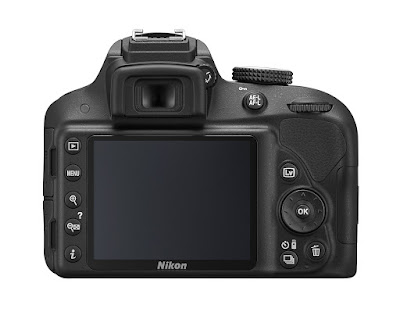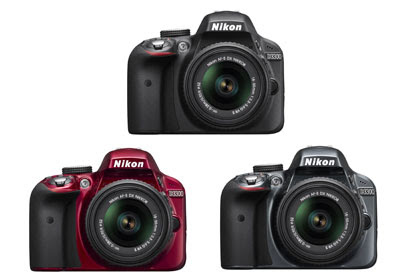With somewhat better photo quality and slightly better
performance, the Nikon D3300 delivers a modest improvement over its predecessor
the D3200 -- enough to bump up its rating and improve its status relative to
some competitors, but no so much that it's definitively worth the extra money
over the D3200 for buyers on tight budgets. The rest of the updates, such as
1080/60p video, a redesigned beginner's Guide Mode, plus a slightly smaller,
lighter body, barely move the needle. It retains the same 11-point autofocus
system of its predecessor, and lacks built-in Wi-Fi; you still have to go
dongle for that.The Nikon D3300 is a solid camera, in more ways than one: solid
build quality and solid image quality. While autofocus performance is a little
below average, and the limited external controls and smaller size may be a turn
off for some, the D3300 excels in most areas. If you're ready to make the jump
to a DSLR camera, the Nikon D3300 provides a nice starting point with a great
combination of image quality, ease of use and price.
Build And Design:
Externally, the D3300 appears a virtual twin to the D3200,
with some slight contour changes to the body and a minor relocation of a couple
buttons on the rear of the camera. The overall design is what you expect from a
modern DSLR, which is to say a rounded rectangular form with a prominent
handgrip and protruding pentaprism/built-in flash housing situated atop the
body. Body construction is of composite materials with a metal lens mount and
Nikon has managed to shave nearly 1 ounce of body weight compared to the D3200,
apparently through the inclusion of carbon fiber. The camera is manufactured in
Thailand and materials, fit and finish appear commensurate with the price
point.
Features:
24.2 megapixel DX-format CMOS image sensor
Razor-sharp 11-point AF system
5 fps continuous shooting
3.0 inch (921k dots) TFT LCD
ISO 100-12800 (extendable to 25,600 equivalent)
EXPEED 4
1080p Full HD Video
Wi-Fi connection with the optional WU-1a adapter
Menus and Modes:
Menus in the D3300 are simple and short, in keeping with the
camera’s entry-level DSLR status: a two-page playback menu, two-page shooting
menu, four page setup menu, three page retouch menu and three-page recent
settings menu. Some menu items may not be available depending on shooting mode.
The retouch menu is fairly expansive and offers a number of
tools for image manipulation, such as D-lighting, redeye correction, RAW
processing, resizing, quick retouch, distortion control and movie editing.
Here’s a look at a backlit shot of a meerkat along with the same shot after
“quick retouch” applied in camera.
The View NX2 software provided with the camera also contains
a browser, movie editor, RAW converter, D-lighting and image adjustments
including exposure compensation, white balance, picture control, sharpness,
contrast, brightness, highlight protection, shadow protection, color booster, a
crop tool, straighten tool, auto redeye, axial color aberration and auto
lateral color aberration.
Shooting modes are what you would expect from an entry-level
DSLR, combining fully automatic “point and shoot” type options including scenes
and a guide mode along with more traditional manual and semiautomatic settings.
1. Auto-a fully automatic mode with the camera determining the
majority of settings; user has inputs to image quality and size, flash
operation, focus mode and autofocus area mode.
2. Auto, flash disabled-fully automatic mode identical to auto
with the exception of no flash capability.
3. Guide-a tutorial mode offering instruction/suggestions on
shooting, viewing or deleting images, retouching images, and camera set up.
While not a shooting mode in the strictest sense, the shooting menu can guide
users to camera setups for capturing certain types of images.
4. Scenes-fully automatic mode with the camera optimizing
settings for particular subjects; the mode dial provides icons for portrait,
landscape, child, sports, close-up and night portrait options. User inputs are
limited and may vary depending on the particular scene chosen.
5. Effects-fully automatic mode with the camera applying
special effects as determined by the user; rotation of the command dial can
call up night vision, super vivid, pop, photo illustration, color sketch, toy
camera effect, miniature effect, selective color, silhouette, high key, low
key, HDR painting or easy panorama effects. User inputs are limited and may
vary depending on the effect chosen.
6. Program auto-automatic mode with the camera setting aperture
and shutter speed; user has a wide variety of inputs and can vary the
aperture/shutter settings originally selected by the camera by rotation of the
command dial.
7. Aperture priority-user sets aperture, camera sets shutter
speed and user has a wide variety of inputs.
8. Shutter priority-user sets shutter speed, camera sets
aperture and user has a wide variety of inputs.
9. Manual-user sets shutter speed and aperture and has a wide
variety of inputs.
Movie-NTSC mode: capture video at 1920 x 1080 60p; 1920 x
1080 30p; 1920 x 1080 24p; 1280 x 720 60p; 640 x 424 30p. PAL mode: 1920 x 1080
50p; 1920 x 1080 25p; 1920 x 1080 24p; 1280 x 720 50p; 640 x 424 25p. Maximum
movie file size is 4 GB; maximum full HD/high movie quality length at 60 or 50p
is 10 minutes or 20 minutes at normal movie quality. H.264/MPEG-4 Advanced
Video Coding, linear PCM audio. A stereo microphone jack is provided.
Performance:
Overall, the D3300 tests faster than the D3200 and many of
its competitors, but it still feels pretty slow to shoot with -- possibly
because of the relatively sluggish new kit lens. It takes half a second to
power on, focus, and shoot; that's not bad. Time to focus and shoot in good
light runs about 0.4 second, rising to 0.6 second in dim light. It does perform
quite fast when shooting two consecutive photos, 0.2 second regardless whether
you're using raw or JPEG, since it doesn't attempt to refocus, rising to 0.9
second with flash enabled.
Live View performance remains terrible, taking almost 2
seconds to focus and shoot thanks to slow everything -- slow autofocus, slow
mirror movement -- and two consecutive JPEG shots takes 3.7 seconds.
The camera delivers an excellent 5.1fps burst when equipped
with a 95MB/sec SD card (almost 4.4fps for raw) with autofocus and with no
significant slowing -- it just gets a little more variable -- for more than 30
frames. However, the autofocus can't really keep up with the frame rate so
there are a lot of misses.
The annoying small, dim viewfinder hasn't changed,
unsurprising since that's typical for these entry-level models. I really
dislike the tiny focus points which only illuminate (and briefly) when you
half-press the shutter. They're impossible to see in moderate to dim light, so
if you shoot on anything other than full auto you first have to press the
shutter to find the appropriate focus point (in my case, center) before you can
even begin to frame the scene. The LCD hasn't changed, but it's a good size,
bright and reasonably visible in bright sunlight.
Image quality:
Photos are the camera's strongest suit. The D3300 improves
on the image quality of the D3200, with most images appearing somewhat sharper
as you'd expect from the new 24-megapixel antialiasing-filter-free sensor, and
the camera fares pretty compared to competitors. Also, for example, ISO 3200
JPEGs look a lot less noisy than their counterparts from the D3200, but the raw
files seem to clean up about the same, pointing mostly to the inevitable
improvements in Nikon's image processing over the past two years. JPEGs look
very clean through ISO 400 and display only minimal artifacts through ISO 1600.
Depending upon scene content the photos are usable through ISO 6400, but above
that the less-bright colors become too desaturated and the tonal ranges
compress unattractively.
Nikon D3300 vs Nikon D3200: What's the differences?
The resolution may be the same as the D3200, but the D3300 has plenty of other improvements under the bonnet. Chief among these is the new Expeed 4 image-processing engine. Nikon’s fastest processor yet, it improves the D3300’s ISO sensitivity to an impressive maximum of 25,600 and its shooting rate to 5fps – not top of the league but very impressive for an entry-level camera. There are also a few new automatic flash modes, including an option for fill flash.
It’s worth noting that there is plenty that remains the same
from the previous model in the series. You’ve got an 11-point AF system, a
3-inch 921k-dot rear screen and a 420 pixel RGB sensor metering system, all
things that D3200 users will find thoroughly familiar. The D3300 shoots images in
JPEG and 12-bit Raw formats, and is capable of saving them to SD, SDHC or SDXC
memory cards.
Elsewhere there are a number of other optional extras on the
D3300. You can attach the Nikon GP-1 module to a socket on the side of the
camera in order to geotag images. There are also a number of additional
shooting modes: a Rangefinder Mode (finding which requires a little digging
into the menus); Mirror Lock-Up, though only for sensor cleaning, not for
shooting; Easy Panorama, which automatically stitches several images together;
and Effects Mode, with visual filters such as high-key and Selective Color.
Where To Buy?
You have multiple options to buy “Nikon D3300 DSLR DigitalCamera“. But I recommend you to order this stylish bag from DigitalRev. They
are world’s famous camera accessories seller. Most importantly they do not
charge any shipment cost.




Nikon has once again created highlights and marked its place in the history of technological advancements with the release of their Nikon D3300.
ReplyDeleteNikon D3300 DSLR Reviews